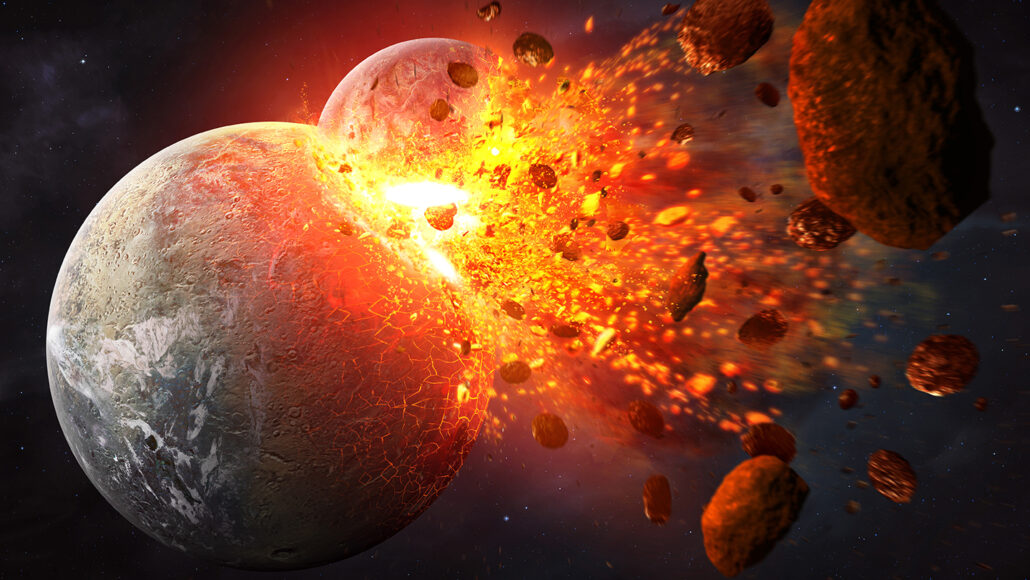One collision could have formed the moon and started plate tectonics
If true, this scenario could help in the search for other Earthlike worlds

Earth’s moon is thought to have formed when a Mars-sized planet collided with Earth about 4.5 billion years ago. Now, computer models suggest the impact could have also kick-started Earth’s plate tectonics.
Tobias Roetsch/Future Publishing via Getty Images
By Nikk Ogasa
THE WOODLANDS, TEXAS — Our moon is thought to have formed when a Mars-sized planet called Theia slammed into early Earth. That smashup would have kicked a cloud of debris into space that later clumped together to form the moon. Now, computer models suggest that bits of Theia left deep inside Earth could have kick-started plate tectonics. That’s the continual shuffling of pieces of Earth’s surface.
Qian Yuan shared this idea March 13 at the Lunar and Planetary Science Conference. Yuan studies how the inner layers of Earth move and affect the surface at Caltech in Pasadena, Calif. His team’s research offers a neat explanation for how Earth got both its moon and its moving plates. If it’s true, that knowledge could help astronomers spot Earthlike worlds around other stars. But some scientists caution that it’s way too early to say that this is, in fact, what happened to Earth.
Of all the worlds discovered so far, ours is the only one known to have plate tectonics. For billions of years, Earth’s creeping plates have spread, collided and plunged beneath one another. This motion has birthed and split continents. It has pushed up mountain ranges. And it has widened oceans. But all this reshaping has also erased most of the planet’s early history. That includes how and when plate tectonics first began.
To answer this question, Yuan and his colleagues focused on two continent-sized blobs of material in Earth’s lower mantle. Some scientists think these regions formed from old tectonic plates that slipped deep down into Earth. But Yuan’s team thought the mysterious masses could instead be the dense, sunken remnants of Theia. So, the team built computer models of this scenario. The models showed how Theia’s impact and sunken remains would affect the flow of rock inside Earth.
Once Theia’s remains had sunk to the bottom of the mantle, these hot blobs of material could have caused large plumes of warm rock to rise up. That rising material would have wedged into Earth’s rigid outer layer. As more material rose, these plumes of warm rock would have ballooned. Eventually, they would have swelled so much that they pushed slabs of Earth’s surface beneath them. When pieces of Earth’s surface slip down into the mantle, it’s called subduction. And subduction is a main feature of plate tectonics.
According to the models, subduction — and therefore plate tectonics — would have started about 200 million years after the moon formed.
The models do suggest the large blobs in Earth’s lower mantle could have helped start subduction, says Laurent Montési. But it’s not yet clear whether these masses came from Theia. At the University of Maryland in College Park, Montési studies how the surfaces and layers of planets move.
The blobs “are a fairly recent discovery,” he says. “They’re very fascinating structures, with a very unknown origin.” So, Montési thinks it’s too early to say that Theia triggered plate tectonics.
If this idea does turn out to be true, it could help pick out Earthlike planets beyond our solar system. “If you have a large moon, you likely have a large impactor,” Yuan said at the conference. If you have a large impactor, that might mean you have plate tectonics.
Scientists have yet to confirm the discovery of a moon around a planet in another solar system. But keeping an eye out, Yuan said, could help us uncover another world as tectonically active as our own.







